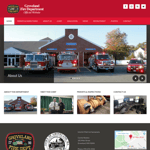Timothy J. Grenno, Fire Chief
56 Temple St.
Whitman, MA 02382
For Immediate Release
Saturday, July 15, 2017
Contact: John Guilfoil
Phone: 617-993-0003
Email: john@jgpr.net
Whitman Firefighter Graduates from State Firefighting Academy
STOW — Fire Chief Timothy J. Grenno is proud to announce that a new Whitman firefighter graduated yesterday from the 255th class of the Massachusetts Firefighting Academy after a 50-day intensive Career Recruit Firefighter Training Program.
Firefighter Ryan Benton is a Whitman native and Whitman-Hanson Regional High School alumnus. He was one of 36 graduates (34 men and two women) representing the 19 fire departments of: Burlington, Cambridge, Falmouth, Framingham, Franklin, Leominster, Mansfield, North Attleboro, Natick, Needham, New Bedford, Newton, Norfolk, Sandwich, Somerville, Sudbury, Tewksbury, Whitman, and Yarmouth.
Firefighter Benton has a strong public safety pedigree. His father is Whitman Police Chief Scott D. Benton.
“I am extremely proud of Firefighter Benton as he joins the Whitman Fire Department full-time after graduating,” Chief Grenno said. “The Massachusetts Fire Academy Career Recruit Firefighting Training Program provides modern firefighters with a litany of skills that are necessary to respond to the wide variety of emergencies that we encounter on a regular basis.”
The Massachusetts Firefighting Academy (MFA), a division of the Department of Fire Services, offers this program tuition-free. The ceremony took place at the Department of Fire Services in Stow.
“This rigorous professional training provides our newest firefighters with the basic skills to perform their jobs effectively and safely,” said State Fire Marshal Peter J. Ostroskey.
The ceremony featured remarks from a guest speaker, retired Leominster Fire Chief Alfred LeBlanc, who is an instructor at the academy and discussed the importance of training and advancing their education throughout their careers.
Firefighter Benton will start on shift Monday as a the newest full-time member of the Whitman Fire Department.
Today’s Firefighters Do Far More than Fight Fires
Today’s firefighters do far more than fight fires. They are the first ones called to respond to chemical and environmental emergencies, ranging from the suspected presence of carbon monoxide to a gas leak. They may be called to rescue a child who has fallen through the ice or who has locked himself in a bathroom. They rescue people from stalled elevators and those who are trapped in vehicle crashes. They test and maintain their equipment including self-contained breathing apparatus (SCBA), hydrants, hoses, power tools, and apparatus.
At the Massachusetts Firefighting Academy they learn all these skills and more from certified fire instructors who are also experienced firefighters. Students learn all the basic skills they need to respond to fires and to contain and control them. They are also given training in public fire education, hazardous material incident mitigation, flammable liquids, stress management, confined space rescue techniques, and rappelling. The intensive, ten-week program for municipal firefighters involves classroom instruction, physical fitness training, firefighter skills training, and live firefighting practice.
Starting with Class #247, the Mass. Firefighting Academy’s Career Recruit Firefighter Training Class shifted from a 9-week to a 10-week program. Instead of three recruit classes of 24 students every three weeks, the academy now has two classes of 36 recruits every five weeks. There is still a total of 72 recruits on the Stow campus all the time. The longer program adds more practical time for recruits, including training in water rescue, power saws, additional live fire training, and more focus on Firefighter I/II practical skills.
Basic Firefighter Skills
Students receive classroom training in all basic firefighter skills. They practice first under non-fire conditions and then during controlled fire conditions. To graduate, students must demonstrate proficiency in life safety, search and rescue, ladder operations, water supply, pump operation, and fire attack. Fire attack operations range from mailbox fires to multiple-floor or multiple-room structural fires. Upon successful completion of the Recruit Program all students have met national standards of National Fire Protection Association 1001 and are certified to the level of Firefighter I and II, and Hazardous Materials First Responder Operational Level by the Massachusetts Fire Training Council, which is accredited by the National Board on Fire Service Professional Qualifications
###
Discover more from John Guilfoil Public Relations
Subscribe to get the latest posts sent to your email.

